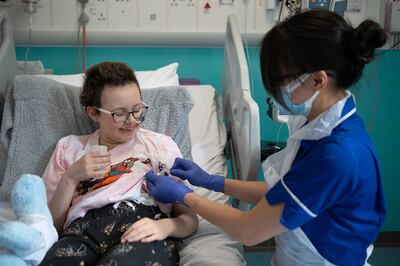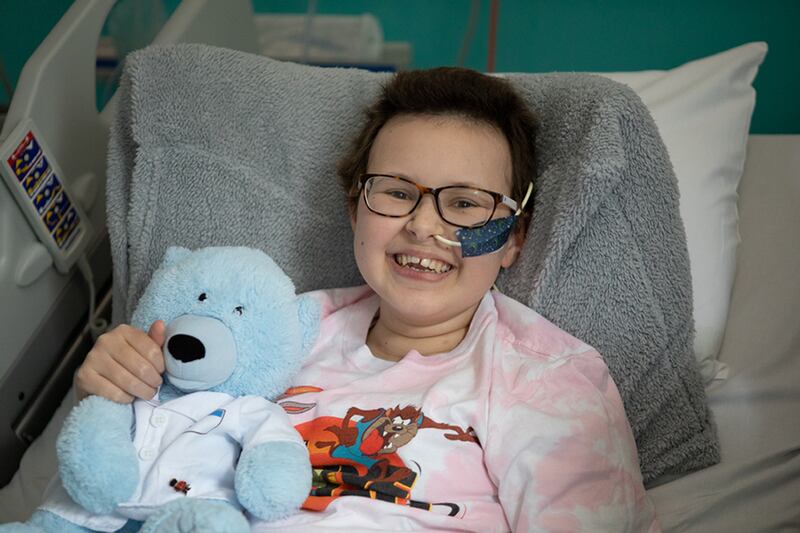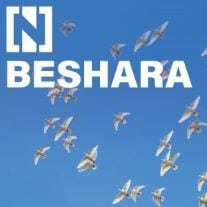A 13-year-old girl is free of leukaemia after the world's first use of what scientists have described as the most sophisticated cell engineering to date.
The teenager, called Alyssa, said she felt that volunteering for the experimental new treatment for the disease would help others. “Of course I’m going to do it,” she said.
Scientists said that without the treatment, which came after chemotherapy and an initial bone marrow transplant failed to clear her cancer, her only alternative would have been palliative care.
Speaking about the therapy, Alyssa said: “Once I do it, people will know what they need to do, one way or another, so doing this will help people.”
The teenager, from Leicester, received base-edited T-cells in the first ever use of a base-edited cell therapy at Great Ormond Street Hospital for Children.
Pre-manufactured cells from a healthy volunteer donor were edited to enable them to hunt down and kill cancerous T-cells without attacking each other.
T-cells are white blood cells that move around the body, finding and destroying defective cells.
Alyssa, who was diagnosed with T-cell acute lymphoblastic leukaemia, or T-All, in 2021, was given all the conventional treatments including chemotherapy and a bone-marrow transplant, but the disease returned.
She then became the first patient enrolled on to a new clinical trial, funded by the Medical Research Council, during which she was given universal Chimeric Antigen Receptor T-cells that had been pre-manufactured from a healthy volunteer donor in May this year.
The researchers described base-editing as chemically converting letters of the DNA code that carry instructions for a specific protein.
The edited Car T-cells can be given to a patient so that they quickly find and destroy T-cells in the body, including cancerous ones, after which the person can have a bone-marrow transplant to restore their depleted immune system.
Twenty-eight days after being given the treatment, Alyssa was in remission, researchers said, and was able to have a second bone marrow transplant.

She is said to be “doing well at home” as she recovers and continues with follow-up monitoring at the hospital.
It is hoped the research, due to be presented for the first time at the American Society of Haematology annual meeting in New Orleans in the US, could lead to new treatments and “ultimately better futures for sick children”.
Scientists aim to recruit up to 10 patients who have T-cell leukaemia and have exhausted all conventional options for the clinical trial into the new treatment.
Medics at Great Ormond Street hope that if it is successful it can be offered to children earlier in their treatment when they are less sick and that it can be used for other types of leukaemia in future.
Potential patients for trials will be referred by NHS specialists.
Prof Waseem Qasim, consultant immunologist at Great Ormond Street, said: “This is a great demonstration of how, with expert teams and infrastructure, we can link cutting-edge technologies in the lab with real results in the hospital for patients. It’s our most sophisticated cell engineering so far and paves the way for other new treatments and ultimately better futures for sick children.
“We have a unique and special environment here that allows us to rapidly scale up new technologies and we’re looking forward to continuing our research and bringing it to the patients who need it most.”
Alyssa’s mother Kiona said the family were “on a strange cloud nine” and that it was “amazing to be home”.
She said: “Hopefully this can prove the research works and they can offer it to more children — all of this needs to have been for something.”
Dr Robert Chiesa, consultant in bone marrow transplant and Car T-cell therapy at the hospital, said: “Since Alyssa got sick with her leukaemia in May last year, she never achieved a complete remission — not with chemotherapy and not after her first bone marrow transplant. Only after she received her CD7 Car-T cell therapy and a second bone marrow transplant has she become leukaemia-free.”
He described the outcome as “quite remarkable” but cautioned that it must be monitored and confirmed over the next few months.







